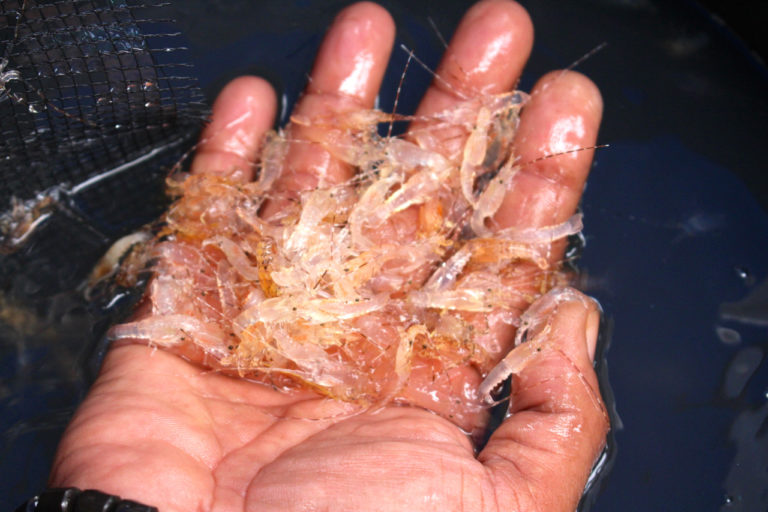- A decision allowing the resumption of lobster larvae exports threatens a national park in Indonesia that’s the last refuge of the critically endangered Javan rhino.
- Only 72 of the rhinos are left on Earth, and tend to frequent a coastal area of Ujung Kulon National Park that is now open to lobster fishers under a controversial decision by the fisheries ministry.
- Park officials and conservationists say the biggest threat to the species is human activity, and a potential influx of more than 300 fishers into their habitat could prove devastating.
- Conservationists say there needs to be an ecosystem-wide solution that minimizes the threat to the rhinos while also considering the livelihood of local fishers.
JAKARTA — The Indonesian government’s controversial decision to allow the resumption of lobster larvae exports now threatens another, far more endangered, species: the Javan rhino.
The last remaining habitat of the Javan rhino (Rhinoceros sondaicus) is Ujung Kulon National Park at the western tip of the island of Java. But the shores of the park have effectively been opened up to lobster fishers under a decision in May by the fisheries ministry to reverse a ban on exports of wild-caught lobster larvae.
Mochamad Syamsudin, the coordinator of the rhino monitoring and protection unit at Ujung Kulon, said the rhinos often frequent the area by the coast. Under the resumption of wild lobster harvests, up to 120 motorized fishing boats, each carrying up to three fishers, will be eligible to operate in the area, Syamsudin said. In addition to fishing, they typically land to rest or swim by the shore, he added.
“Rhinos are very shy, and any human activity will certainly disturb the space of the Javan rhinos,” Syamsudin told Mongabay in an interview.

An estimated 72 Javan rhinos — 39 males and 33 females — live in Ujung Kulon, which spans 1,230 square kilometers (475 square mile), about a third of it marine area. The population appears to be growing at a stable rate, but it is the only one left in the world. This is particularly concerning for wildlife experts because an infectious disease or a seismic-triggered tsunami that could wipe out virtually all of the rhinos. (The latter isn’t an outlandish prospect: Ujung Kulon sits within sight of Anak Krakatau, an active volcano whose eruption in December 2018 unleashed a tsunami that killed 400 people, including two park officials.)
The park, although a protected zone, also suffers from a persistent problem of illegal human activities, ranging from logging to hunting. Sites like Cibandowoh, where lobster harvests are expected to resume, are important for the rhinos as part of their home range, said Widodo Ramono, the executive director of Indonesia Rhino Foundation (YABI).
“We all know that actually the disturbance to the rhinos is mainly human activities,” Widodo said in a recent webinar.
Rhino conservation experts and officials say they’re concerned that allowing the resumption of lobster larvae exports will encourage a surge in harvests from the wild, leading to an increase in human activity around the coast of Ujung Kulon.
“There were a lot of people catching the larvae within the conservation area even when it was still banned, and that was already disturbing the Javan rhino habitat. Imagine what it’ll be like now that it’s allowed,” Syamsudin said.

The fisheries ministry has granted export permits for lobster larvae to 31 companies. These firms have to partner with fishermen in harvesting the larvae and cultivating them in aquaculture farms. Only by demonstrating they can produce a “sustainable harvest” from these lobster farms will they be allowed to start exporting. But a recent investigation has shown that the policy, which only came out in May, has already resulted in export shipments by companies with political links to the fisheries minister.
Syamsudin said the Ujung Kulon park agency had increased protection and monitoring efforts around the rhino habitat, and carried out community outreach to discourage locals from encroaching into the park.
Conservation experts have called on the fisheries and environment ministries and the park agency to establish a management strategy for the rhinos and for the lobster fishers in Ujung Kulon.
“Species management planning must be thought out based on the ecosystem as a whole,” said Harini Muntasib, a conservation expert from the Bogor Institute of Agriculture (IPB).

FEEDBACK: Use this form to send a message to the author of this post. If you want to post a public comment, you can do that at the bottom of the page.